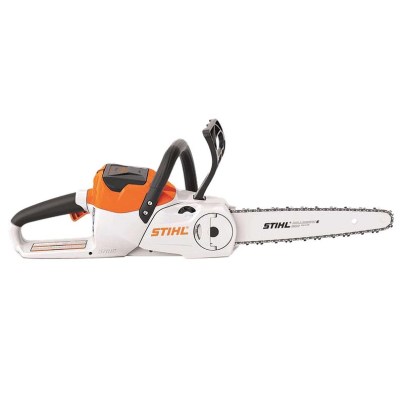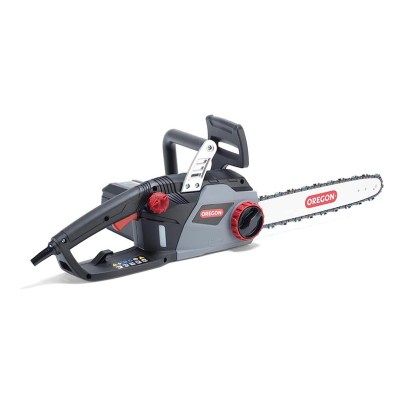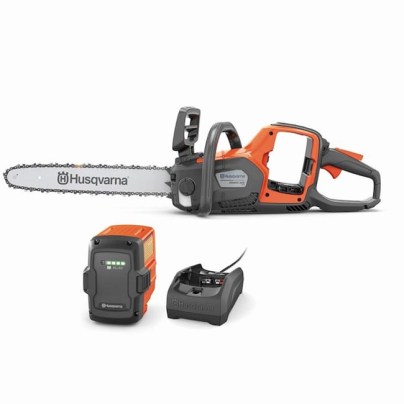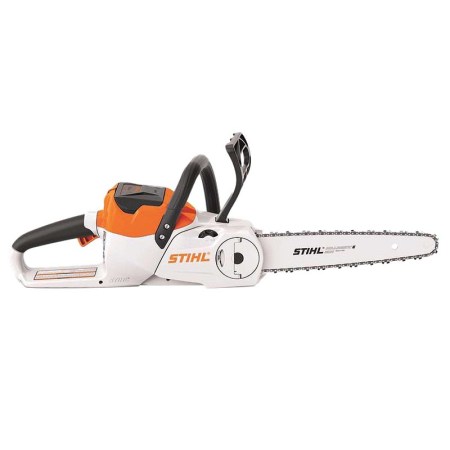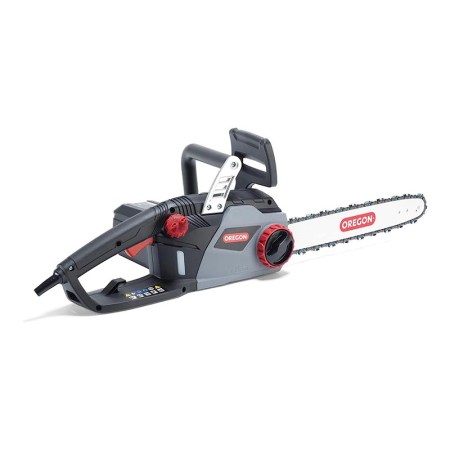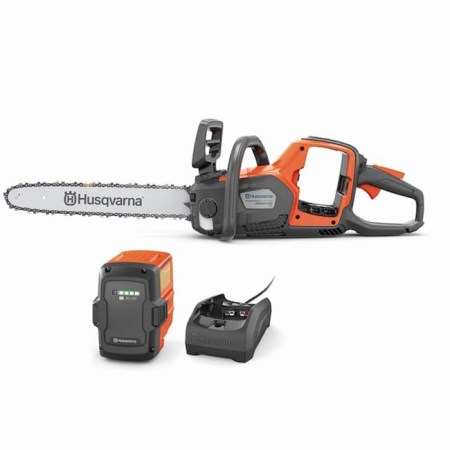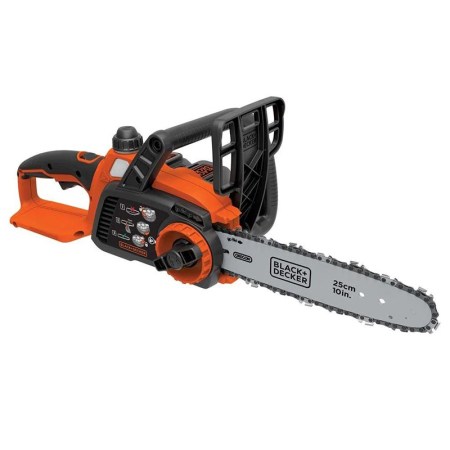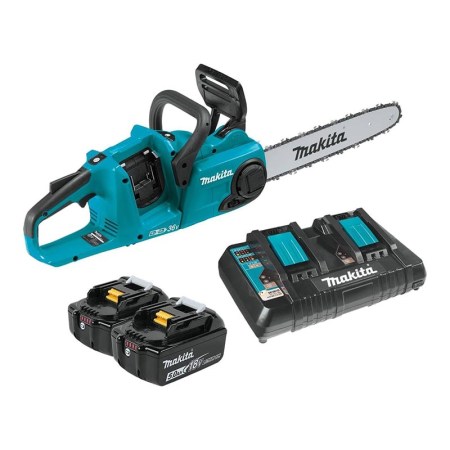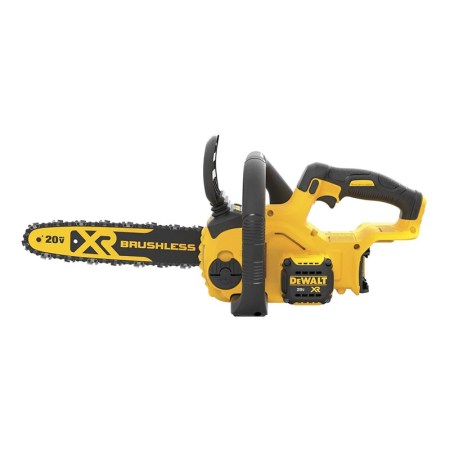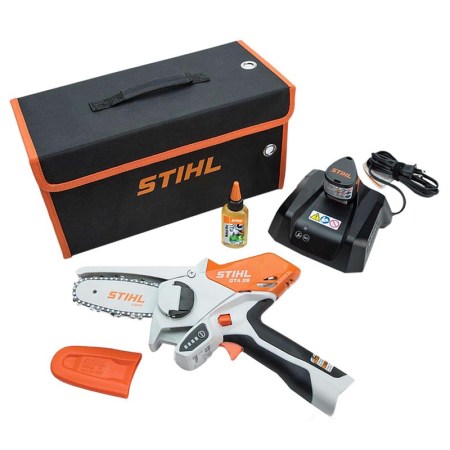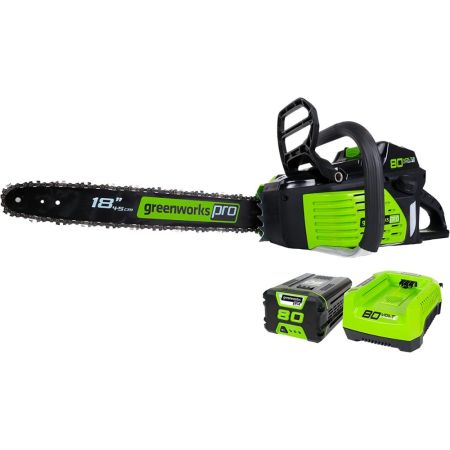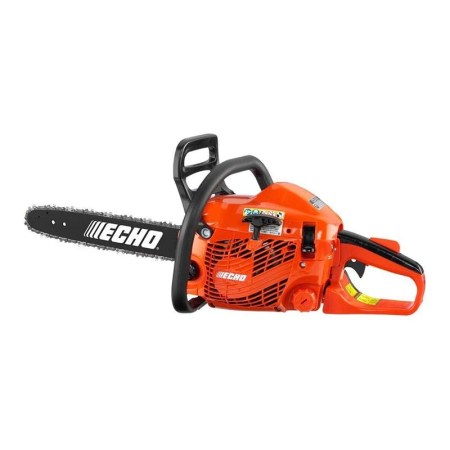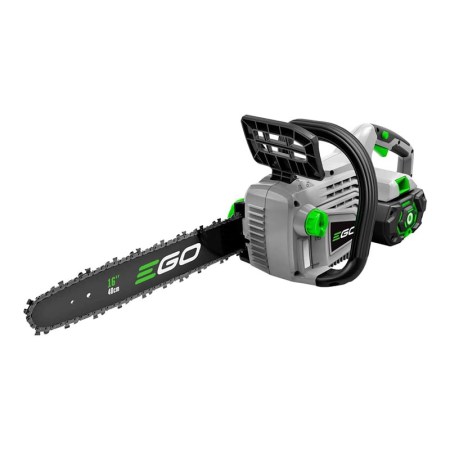We may earn revenue from the products available on this page and participate in affiliate programs. Learn More ›
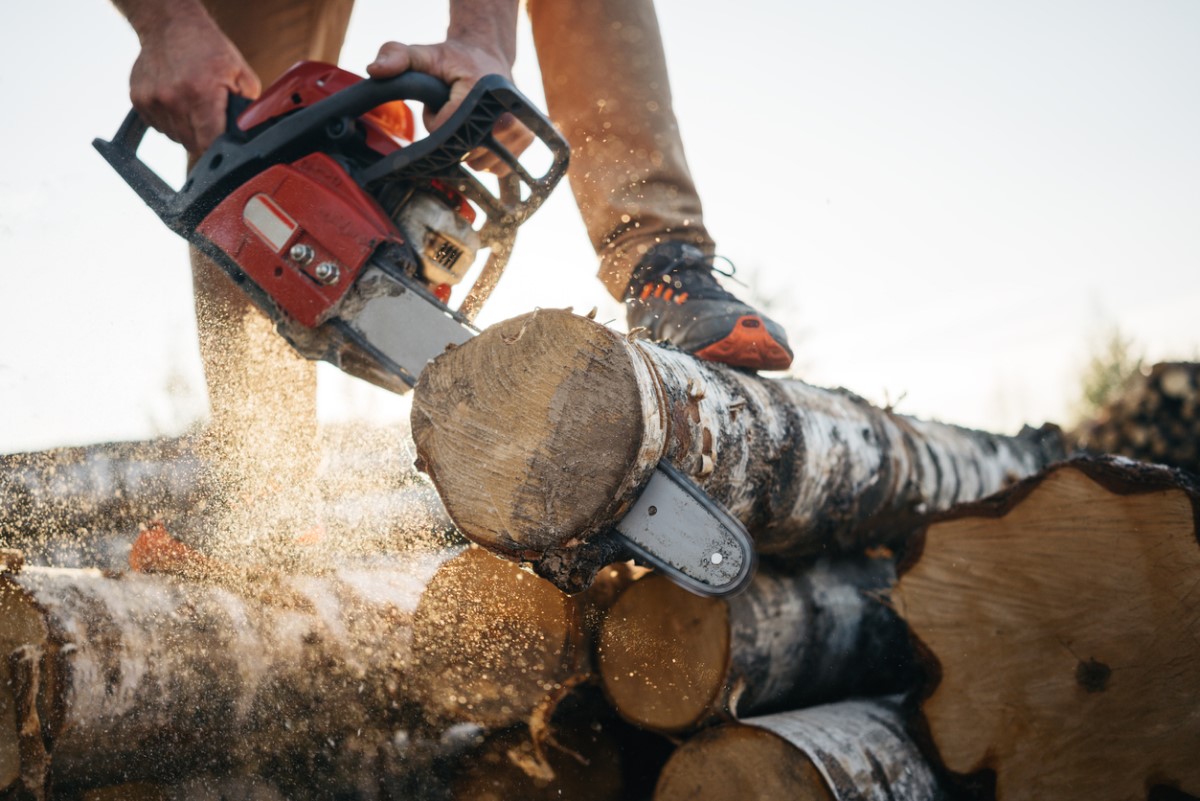
Landscapers and lumberjacks, whether pros or DIYers, need reliable chainsaws for maintenance, cleanup, and cutting firewood. That said, those needs vary. Over the last couple of years, we’ve tested more than two dozen chainsaws, including corded chainsaws, battery chainsaws, mini chainsaws, and traditional gas chainsaws—all from the best chainsaw brands. The outdoor tools on this list represent the top options for nearly every type and size of wood-cutting job. Whether you need to do some light pruning or heavy-duty felling, a chainsaw below can help get the job done.
- BEST OVERALL: Stihl MSA 140 C-B Battery Chainsaw Kit
- BEST BANG FOR THE BUCK: Oregon CS1400 16-Inch Corded Electric Chainsaw
- BEST HEAVY-DUTY: Husqvarna Power Axe 350i With Battery Charger
- BEST LIGHT-DUTY: Black+Decker 20V 10-Inch Cordless Chainsaw
- BEST FOR HOME USE: Makita 36V LXT Brushless 14-Inch Chainsaw Kit
- BEST COMPACT: DeWalt 20V MAX XR Compact 12-Inch Cordless Chainsaw
- BEST MINI: Stihl GTA 26 Garden Pruner Kit
- BEST FOR FIREWOOD: Greenworks 80V 18-Inch Cordless Battery Chainsaw
- BEST GAS: Echo CS-310 14-Inch Chainsaw
- ALSO CONSIDER: Ego Power+ 16-Inch Chainsaw
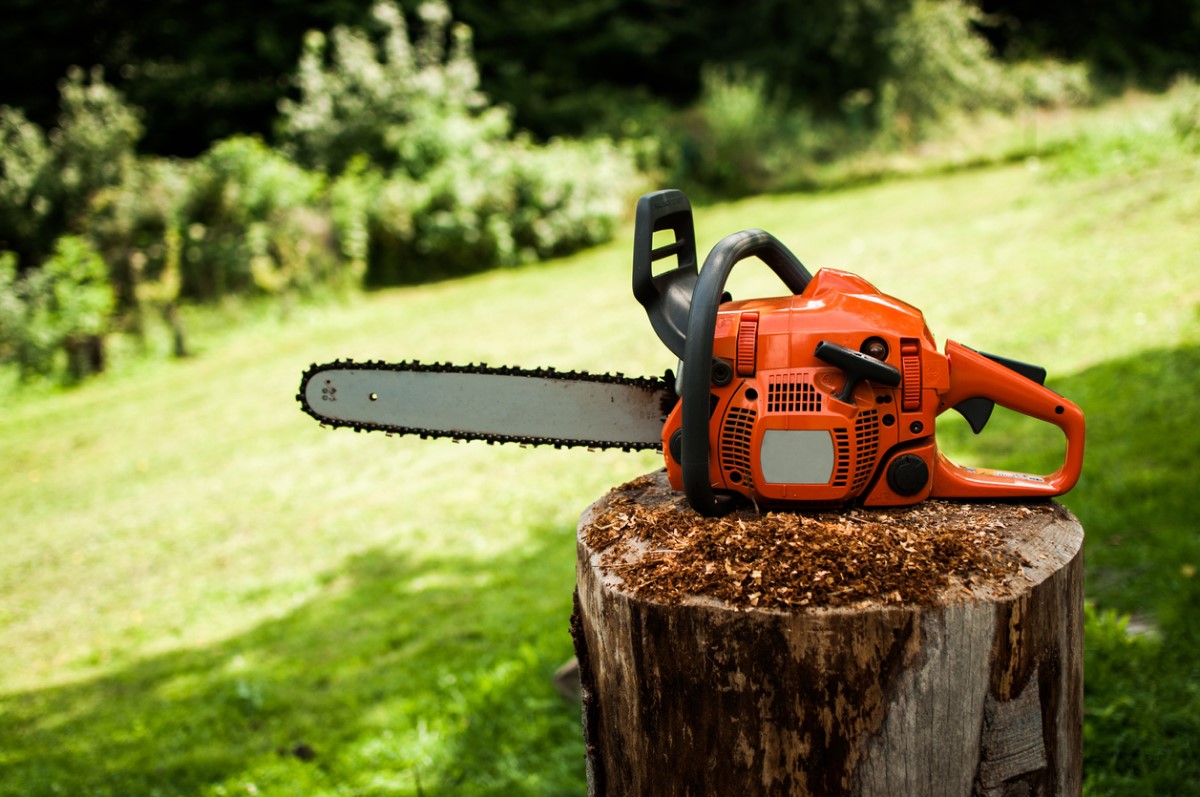
How We Tested the Best Chainsaws
We researched nearly 100 chainsaws in various categories and sifted through features including size, power output, weight, ergonomics, and more to determine the best models for testing. We also took into account user preferences to ensure we included enough variety on this list. Some shoppers, for instance, favor cordless electric chainsaws for their maneuverability and ease of use, while others choose corded electric chainsaws for unlimited runtime and durability. As for cutting power, our picks can complete light- to heavy-duty work with up to 80 volts (V) or 15 amps of power for electric models.
Because we tested a variety of chainsaws and brands, we evaluated each one’s cutting power according to its intended purpose rather than putting them all in a head-to-head competition. We limited smaller chainsaws to yard cleanup, shrub removal, and branch-cutting duties, while we used the larger saws to fell several dead trees and cut them into firewood. In addition to evaluating each chainsaw’s cutting capability, we also assessed noise, vibration, maneuverability, safety, and overall ease of use.
Our Top Picks
Based on our testing, we’ve found that these are some of the best tools that can help you manage trees, collect firewood, and more.
Best Overall
Stihl MSA 140 C-B Battery Chainsaw Kit
See ItOur top pick comes from a revered legacy brand, and it’s packed with performance details and user comforts that make it one of the best chainsaws—gas or electric. The Stihl MSA 140 C-B battery-powered chainsaw weighs just 8.6 pounds with battery and comes equipped with a 12-inch guide bar. An efficient brushless motor, compact build, and efficient narrow-kerf chain make it a great choice for pruning, yard cleanup, and light tree work.
The kit includes a bar sheath, ¼-inch PM3 saw chain, AK 30 36V battery, and AL 101 battery charger. The saw runs up to 45 minutes per charge. One of the quieter saws we tested, it’s a great choice for working in neighborhoods. But it also produces high torque with very low vibration for efficient cutting and a comfortable user experience.
We enjoyed the overall performance of the MSA 140 C-B. It worked smoothly and efficiently for well over an hour per charge, including stoppage between cuts. Relative to the other saws we tested, almost no vibration transferred through the handles, and the narrow saw body gave it better balance than most of the others.
The short bar helped when working selectively around dense branch growth, and the lightweight motor made it easy to cut branches at chest height without causing excessive back and shoulder strain. This could be an excellent primary yard maintenance chainsaw for anyone, or a backup limbing saw for serious woodcutters.
Product Specs
- Power source: 36V battery
- Bar length: 12 inches
- Weight: 8.6 pounds
Pros
- Lightweight, balanced design for outstanding work stability and safety
- 5.2 amp-hour (Ah) battery powers up to 45 minutes of cutting per charge
- Efficient ¼-inch PM3 saw chain cuts quickly with low vibration
- Ideal bar size for cleaning up debris, pruning branches, or limbing fallen trees
Cons
- Undersized for heavy-duty felling and bucking of larger trees
- 3-hour recharge time with the included charger could cut the workday short
Get the Stihl MSA 140 chainsaw at Ace Hardware or Stihl.
Best Bang for the Buck
Oregon CS1400 16-Inch Corded Electric Chainsaw
See ItThe Oregon CS1400 packs in numerous feature upgrades for such a budget-friendly saw. As a corded electric saw, it offers unlimited runtime wherever there is access to a power outlet. It comes equipped with a heavy-duty 15-amp motor and uses a toolless chain-tensioning system, allowing you to adjust the chain to the proper tension and lock it back into place with ease. One of the best features of this rigid chainsaw is how quiet it is when cutting while still providing plenty of power to get the job done.
To preserve the bar and chain, the automatic oiler distributes oil onto the parts. This helps preserve a sharp chain, keeps the chainsaw lubricated, and prevents it from wearing out prematurely.
In terms of raw cutting power, the Oregon CS1400 performed as well as any other saw we tested. Although it was heavier than many of the other tested saws, the weight added stabilizing downward pressure for smooth bucking/sectioning cuts. That being said, we also noted that the saw was not as easy to operate on its side, as is needed to fell a tree. The heavier weight and the need to manage the power cord made it less maneuverable in densely branched tree canopies, too. But, it’s a great choice for making lots of vertical cuts in a relatively clear workspace, as in cutting cordwood to length.
Product Specs
- Power source: 15-amp household electrical outlet (15-amp motor)
- Bar length: 16 inches
- Weight: 12.2 pounds
Pros
- Relatively affordable compared to battery models with similar features
- Can easily handle thick and dense hardwood; ideal for large yards
- Heavy-duty cutting power equivalent to that of midsize gas chainsaws
- Corded for prolonged use; no need to worry about refueling or recharging
Cons
- Requires a nearby electrical outlet and a heavy-duty extension cord (not included)
- Heavier and less maneuverable than most cordless chainsaws
Get the Oregon chainsaw at Amazon, Lowe’s, The Home Depot, Acme Tools, Northern Tool + Equipment, or Oregon.
Best Heavy-Duty
Husqvarna Power Axe 350i With Battery Charger
See ItThe Husqvarna Power Axe 350i 36-volt chainsaw includes performance, safety, and comfort features a cut above the others on the list. The 18-inch guide bar and X-cut chain complement a low-vibration brushless motor, delivering best-in-class performance.
This saw weighs a relatively modest 14.2 pounds with the battery, bar, and chain installed. For extended battery life, push-button power-boost mode increases output for larger, harder cuts, while normal mode preserves the charge during typical cutting tasks. A tool-free chain tensioner eliminates the need for a chainsaw tool and keeps downtime to a minimum. The 7.5Ah battery works with all Husqvarna battery tools, boosting total power efficiency.
Even the chain is better than on other saws. The Husqvarna X-Cut chain is built to higher standards than the typical saw chain in terms of material, heat treatment, and design of the individual cutters and links to maximize sharpness, cutting efficiency, and durability. It even comes prestretched to eliminate the break-in period typical of a new saw chain.
It is difficult to describe the difference between a low-vibration chainsaw and other saws, but we felt the difference immediately in the Husqvarna Power Axe. The features that minimize vibration transfer through the handles, namely the X-Cut chain and the smooth operating motor, also helped to boost battery life. This translated into a lighter, more capable saw that made more cuts per watt-hour than some of the cheaper saws built on bulkier platforms.
The Power Axe cut up seasoned oak logs into firewood lengths quickly, smoothly, and quietly. And when we were climbing up the crown of a fallen tree, we moved around at will making all the necessary cuts. The narrow saw body and lightweight build made it much more maneuverable than other 18-inch saws, and it outworked the others in pure cutting ability, too. It gave the best overall performance of all the saws we tested, with the possible exception of our top pick, which is built for lighter work. Those in search of a high-performance saw for all types of cutting scenarios would do well to consider the Power Axe.
Product Specs
- Power source: 36V battery
- Bar length: 18 inches
- Weight: 14.2 pounds
Pros
- 18-inch guide bar is the right size for general-purpose cutting tasks
- Much lower vibration than the rest of the saws in our test group
- Fast toolless chain tensioner cuts downtime and boosts productivity
- High-efficiency brushless motor reduces vibration and improves battery life
- X-Cut chain eliminates need to break chain in; retains sharpness longer
Cons
- Heavier and more tiring than a compact chainsaw for light-duty cutting
- 18-inch bar is less articulate for selective cuts among dense branches
Get the Husqvarna chainsaw at Lowe’s.
Best Light-Duty
Black+Decker 20V 10-Inch Cordless Chainsaw
See ItThis affordable battery-powered chainsaw from Black+Decker is an excellent option for those budget-conscious DIYers who need a chainsaw for light-duty use only, as well as those who don’t have a lot of experience operating a chainsaw.
Thanks to a smaller 10-inch blade, which is less likely to kick back, and an overall weight of just 6.8 pounds, it’s easier to manage than larger chainsaws. That’s not to say it isn’t powerful. This chainsaw packs plenty of punch with a 20V battery and can cut through branches up to 8 inches in diameter. User-friendly features include a tool-free chain-tension adjuster and an automatic bar oil system. This Black+Decker chainsaw is sold on its own or with a battery pack and charger.
This model proved to be surprisingly capable while removing a couple of overgrown juniper shrubs in our test area. The compact size and lightweight build made it easy to maneuver among the branches, with very little kickback. It produced some vibration, and the chain speed was slightly slower than some of the other small saws, but it did the job and it worked well in tight spaces.
The low price of this saw appears to be related to the small battery size (battery is not included), which limits runtime to about 15 minutes of work per charge—a design that simply gets the job done with possibly less durable components. One unique design feature that we liked, however, was the placement of the bar oil filler on top of the motor housing, just behind the handle. It eliminated the need to place the saw on its side for filling and made it easier to see the oil level while working. Overall, the saw felt and looked kind of cheap, and indeed it was inexpensive, but it definitely outworked its appearance for short jobs. It’s a good choice to have on hand for light-duty work.
Product Specs
- Power source: 20V battery
- Bar length: 10 inches
- Weight: 6.8 pounds
Pros
- 10-inch blade is highly maneuverable and generates low kickback
- Lightweight and easy to handle; ideal for prolonged use with less fatigue
- Tool-free chain-tension adjuster is easier than dealing with a chainsaw tool
- Affordable compared to similar options; ideal for occasional light work
Cons
- Power, bar length, and weight are not suitable for heavy-duty tree cutting
- Battery and charger not included; sold separately at most retailers
Get the Black+Decker chainsaw at Amazon, Tractor Supply Co., The Home Depot, Acme Tools, or Black+Decker, or Walmart.
Best for Home Use
Makita 36V LXT Brushless 14-Inch Chainsaw Kit
See ItMakita’s cordless chainsaw is an example of the brand’s innovation. It features a dual-battery 18V design, doubling the maximum power and runtime of a standard single-battery chainsaw. Despite those extra batteries, this chainsaw still weighs in at 11 pounds, making it easy to handle.
The brushless motor allows its batteries to distribute more power to the saw than a standard motor, making it as powerful as some gas-powered chainsaws and one of the best battery chainsaw options. With a 14-inch bar, this is a good chainsaw for cutting through trees up to 12 inches in diameter.
Makita’s rechargeable chainsaw also packs plenty of other features like an auto power-off function that shuts the saw down to save battery life when the saw is idle for too long as well as a built-in lock-off that prevents the saw blade from accidentally starting.
In our tests, the Makita’s chain speed was excellent. The tool’s overall balance was pretty good, but the battery configuration had a widening effect on the motor housing, so the center of gravity was farther from the user’s body. This made it slightly less maneuverable than our top pick, but still better than average.
Instead of a mechanical, trigger-release safety switch, this saw uses an on/off power switch that would time-out after a certain period. While awake, a single press of the button activated the saw, but after a few minutes of inactivity, it required two pushes: one to wake up the electronics and the other to power the saw on or off. This was not a deal breaker by any means—just a quirk that some users might not love.
This saw offers excellent cutting power and a good size/weight balance without becoming too heavy during occasional extended use. It’s a really good pick for general work around the house.
Product Specs
- Power source: Two 18V batteries
- Bar length: 14 inches
- Weight: 11 pounds
Pros
- Dual-battery design and efficient brushless motor deliver up to 30 minutes of cutting time
- Auto power-off and lock-off features help to prevent accidental startup
- Offers heavy-duty gaslike power without the pull starts, loud noises, or exhaust fumes
- Battery efficiency, plus batteries are interchangeable with all Makita LXT 18V power tools
Cons
- Battery power can drain quickly when cutting thicker branches or tree trunks
- Shorter runtime per charge compared to some of the others we tested
- On/off switch operation is not intuitive and requires extra attention
Get the Makita chainsaw at Amazon, The Home Depot, or Acme Tools.
Best Compact
DeWalt 20V MAX XR Compact 12-Inch Cordless Chainsaw
See ItNot all users require the power needed to topple tall oaks like a lumberjack. Some just need a chainsaw that can handle simpler jobs, like cutting up small trees after a storm or pruning overgrown branches. Plus, with its no-tool chain-tension adjuster, you won’t have to slow down to make adjustments or lube the chain.
A small saw is very handy for lots of tasks, and at 9 pounds, the DeWalt is also small enough to wield easily. Its balance made working with the saw easy, but it had difficulty in larger and denser material. Surprisingly from a pro brand like DeWalt, we found this tool’s chain speed to be low. However, this compact 12-inch chainsaw is large enough to cut through logs up to 10 inches in diameter with its powerful brushless motor.
Product Specs
- Power source: 20V battery
- Bar length: 12 inches
- Weight: 9 pounds
Pros
- Affordable tool compared to similar options available
- Lightweight design won’t cause fatigue during use
- Brushless motor runs smoothly and provides up to 90 cuts per charge
Cons
- Made for light-duty work only
Get the DeWalt chainsaw at Amazon, Ace Hardware, or The Home Depot.
Best Mini
Stihl GTA 26 Garden Pruner Kit
See ItMini chainsaws, like the Stihl GTA 26, bridge the gap between bypass pruners and conventional small chainsaws. Built for one-handed precision cutting, this garden pruner weighs just 2.7 pounds. The 4-inch guide bar and chain easily remove branches up to 3 inches in diameter. Those searching for an alternative to loppers or a manual pruning saw will appreciate how quickly and easily this pruner gets the job done.
In addition to its lightweight, compact design, the Stihl GTA 26 mini chainsaw features ergonomics to minimize wrist torsion and hand fatigue. The ambidextrous pistol-grip handle is augmented with an upper hand grip on top of the saw for added stability. The bar and chain are removable, with tool-free tensioning for easy maintenance. Plus, this saw needs no bar oil. Just squirt a little of the included machine oil onto the chain before each use for smooth cutting action. The kit includes the saw and battery, charger, and multi oil, all packed in a handy bag.
This little saw definitely has the potential to make gardening and landscaping much easier. We used it to clean up fallen limbs after a storm, to remove low-hanging tree branches that get in the way while mowing, and to prune a few red twig dogwoods. The blade cuts quickly and cleanly, with very little vibration transferring through the handle. We preferred to use both hands when the cuts needed to be precise, but one-handed cutting worked just fine when we were cleaning up debris.
At its list price of nearly $170, this tool might be a bit expensive for some shoppers. They could purchase a really good manual pruning saw and probably a nice pair of handheld pruners for that price. But for those who desire the speed, convenience, or mobility assistance this tool has to offer, it may be worth the investment. Although battery life was limited compared to other chainsaws on the list—20 to 30 minutes depending on the material—this little tool made it much easier to cut off any branch less than 4 inches in diameter.
Product Specs
- Power source: 10.8V battery
- Bar length: 4 inches
- Weight: 2.7 pounds
Pros
- Small 4-inch bar quickly and cleanly removes small branches
- Lightweight; ergonomically designed for 1-handed operation
- LED display indicates tool status and charge level to help you manage your work
- Retractable chain guard adds a layer of protection against flying debris
Cons
- Premium price point for a pruner
- Runtime is limited to 20 to 30 minutes, depending on the material being cut
Get the Stihl GTA 26 chainsaw at Ace Hardware or Stihl.
Best for Firewood
Greenworks 80V 18-Inch Cordless Battery Chainsaw
See ItWith its massive 80V battery and brushless motor, this cordless chainsaw from battery-powered tool specialist Greenworks rivals many similarly sized gas-powered chainsaws. Proving that a small carbon footprint doesn’t equate to wimpy, this formidable chainsaw can make up to 150 cuts before needing a charge, which equates to about 30 minutes of work time per charge. Its 18-inch bar length enables cutting through trunks up to 16 inches in diameter, so this saw is a great option for cutting firewood.
With its rapid charge capability—it needs just 30 minutes for a full recharge—the saw can easily have batteries rotated to avoid lags in productivity. This model is loaded with performance features like steel bucking spikes and an electronic chain brake.
In our tests, the Greenworks Pro 80V chainsaw cut quickly and aggressively, but the battery runtime was not great. At 16 pounds, it was the heaviest saw of our entire group, which was helpful when cutting thick logs into sections, but less so when we were limbing a tree canopy.
We really appreciated the fast chain speed and high torque. The saw didn’t bog down in any of our cutting tests, even when we levered downward on the bucking spikes to add extra pressure on the bar. It cut everything at least as fast as any of the other saws, but the heavy weight, bulky motor housing and battery, and vibration in the handles sacrificed some operator comfort. Still, at the modest list price, it’s a highly capable saw worthy of consideration.
Product Specs
- Power source: 80V battery
- Bar length: 18 inches
- Weight: 16 pounds
Pros
- Long 18-inch bar and chain are suitable for big jobs like felling and bucking
- High-torque motor and fast chain speed facilitate heavy-duty wood cutting
- Good runtime-to-charge-time balance: 30 minutes of runtime, 30 minutes to charge
- Modest price point for a heavy-duty battery-powered chainsaw
Cons
- Heaviest saw in test group
- Chain tensioner feels a bit less robust than we like for heavy-duty work
Get the Greenworks chainsaw at Amazon.
Best Gas
Echo CS-310 14-Inch Chainsaw
See ItCorded electric and battery-powered chainsaws offer numerous benefits, but when conditions are the most demanding, a gas chainsaw is often the best option. The Echo CS-310 is powered by a 30.5-cubic-centimeter 2-cycle gas engine, sports a 14-inch blade, and weighs just 8.8 pounds. It features an automatic clutch-driven oiler, side-access manual tensioner screw, and dual-post chain brake. Pull starts are easier with the help of a spring-assisted starter, and the saw boasts a fully variable speed trigger and an anti-vibration handle. Sold as a kit, it includes a scrench (an essential chainsaw maintenance tool with a built-in screwdriver and spark plug wrench), bar scabbard, and toolless access filter cover.
After we mixed up a fresh batch of 2-cycle fuel and filled the tank, the Echo CS-310 started up on the second pull. It ran smoothly if not quietly and produced no visible smoke. It easily buzzed through hardwood logs up to 14 inches in diameter and ran for just over an hour on one tank (8.5 ounces) of fuel—we stopped counting at 100 cuts. Plus, while some gas saws won’t start easily after they heat up, this one did on the first pull.
We would have preferred this saw to have metal bucking spikes for improved grip instead of the molded plastic ones. Note that gas engines work best when used frequently, so this model would be suited to someone who’ll use it every month at least. It’s a great choice where access to electricity is limited or not available.
Product Specs
- Power source: Gasoline
- Bar length: 14 inches
- Weight: 8.8 pounds
Pros
- Easy to start so users don’t to have to strain to pull the starter cord over and over
- Light weight allows for extended use and better maneuverability
- Powerful, smooth-running engine easily cuts logs up to 14 inches in diameter
Cons
- Molded plastic bucking spikes do not grip as well as metal
- Should be used at least monthly to preserve engine components
Get the Echo chainsaw at Amazon, The Home Depot, or Chain Saws Direct.
Also Consider
Ego Power+ 16-Inch Chainsaw
See ItWith a 16-inch bar, high chain speed, and 5Ah 56V battery in a well-balanced saw, the Ego can make quick work of downed branches, downed trees, or a stack of firewood. In our field tests, the saw delivered good runtime cutting in hardwood. The battery exchange is user-friendly, and the battery gauge is bright and easy to read. The trigger and release switch both work well, too.
This battery-powered chainsaw has a soft start, meaning there’s a slight pause before the chain reaches full speed. Compared to gas-powered chainsaws and some other battery chainsaws, this is a noticeable feature that takes some getting used to. It’s not a detriment for many users, but it is different. Once it’s going, it’s going, and this unit can process some smaller downed trees, branches, and firewood.
The oil filter screen is a generally good feature to help keep chips and debris out of the oil reservoir, but if the bar oil is viscous (as it can be in cold temps), it makes adding oil a slow process because the oil needs to pass through the small apertures of the filter screen. With its 56 volts of power, this tool has a big, heavy battery that’s hungry to make chips.
Product Specs
- Power source: 56V battery
- Bar length: 16 inches
- Weight: 16 pounds
Pros
- Powerful and aggressive tool with 16-inch bar; suitable for downed trees, branches, and firewood
- Good cut capacity and runtime; suitable for small and large cutting
- Water-resistant construction with IPX4 rating
Cons
- Soft start takes some getting used to
- Oil filter can slow adding oil into reservoir
Get the Ego Power+ chainsaw at Amazon, Lowe’s, Ace Hardware, or Acme Tools.
Jump to Our Top Picks
What to Consider When Choosing a Chainsaw
Before shopping, consider a number of important factors common to all the best chainsaws, regardless of power source. This section also explores features relevant to selecting the best gas chainsaw for particular tasks, including intended use, motor, and chainsaw bars.
Bar Size
A description of any chainsaw likely includes the bar size, sometimes referred to as the “guide bar.” (Bars are the steel guide plate the chain runs around.) This measurement is almost always in inches. As a rule of thumb, light-duty chainsaws have a bar from 12 to 14 inches, general-purpose chainsaws have bars that run from 16 to 20 inches, and professional models have bars that are 22 inches or more. The largest chainsaws can exceed 48 inches.
However, exceptions exist. Some high-powered professional chainsaws have shorter bars for added maneuverability. These are often designed for working among branches at height, usually by contractors in climbing harnesses. Strictly speaking, a chainsaw with a 12-inch bar should be able to cut through a 12-inch tree. In practical terms, however, maximum cutting capacities are usually a couple of inches shorter than bar length.
Engine Power (Gas Chainsaws)
The two types of chainsaw engines are two-stroke (also called two-cycle) and four-stroke motors (four-cycle).
- Two-stroke models are lighter and less complicated, which makes them less expensive. They usually run at higher revolutions per minute, so they generate decent power for their size. However, this also makes them noisier, increases fuel consumption, and causes higher emissions.
- Four-stroke chainsaws are heavier, more complex, and produce less power for the same cylinder size. However, they are more fuel-efficient and run cleaner. They’re often more durable as well.
The smallest light-duty gas chainsaws have engine sizes ranging between 30 and 40 cubic centimeters, which is an acceptable size engine for anything from a 10- or 12-inch bar up to 16 inches. For moderate work, like cutting firewood, a 55 cubic-centimeter engine and 16-inch bar are a good standard. The toughest jobs, like felling large trees, call for a professional model with a 65- to 110-cubic-centimeter engine and 16 to 20 inches of bar length.
Motor Power (Electric Chainsaws)
The motor power in electric saws is rated by amperages. An amp rating describes how much power the saw can draw before the internal components will overheat or start breaking down. An 8-amp saw can be considered light-duty, while a 12-amp is for medium-duty work, and a 15-amp is the heaviest duty of electric chainsaws.
Keep in mind that with battery-powered saws, much of the power rating is based on the voltage of the battery used (20V or 40V, for example), not the amp-hour rating on the battery. A battery’s amp-hour rating has more to do with how long the battery will run than the power output.
Although run times will vary depending on use and the chainsaw’s size, expect to get about 30 to 40 minutes of intermittent use out of a cordless chainsaw before it needs a charge. If you already have an arsenal of cordless power tools, consider buying a chainsaw with the same brand to use the batteries interchangeably between your cordless tools.
Weight
Depending on the user’s physical strength, weight can be the most critical consideration of all. If someone is unable to handle a saw safely because it’s too heavy, the fuel source or bar length simply won’t matter.
Corded electric saws and battery-powered saws are often the lightest chainsaws on the market. They don’t require a full tank of fuel mix, and their motors are smaller, so they are lighter weight and easier to use in a variety of scenarios.
Keep in mind, though, that a saw can be too light as well. A top-handle saw with a lot of power, a short bar, and a light motor can act unpredictably if it experiences some kickback. The added inertia of a heavier motor will help minimize the effects of kickback.
Handles
Most chainsaws are designed with two handles: one in the rear that includes the trigger and a larger wrap-around handle in the front for your guiding hand. Given the danger involved with using a chainsaw, the grip is crucial.
Chainsaw handles use rubberized grips that allow you to get a good hold on the chainsaw. The rear handle also incorporates the trigger that activates the saw and a safety switch that engages to shut off the saw should you lose your grip on the rear handle. The front handle curves around the chainsaw, allowing you to hold the chainsaw in various positions for different cuts.
Noise Pollution
If you’d like to maintain a pleasant relationship with neighbors, you may want to consider how much noise a chainsaw can create. Gas-powered saws can be deafening—100 decibels is not unheard of (no pun intended)—so woodcutting is best left to late mornings and afternoons when the fewest people may be sleeping.
Even some electric- and battery-powered options are a little loud. The whine of the electric motor and the noise the chain makes as it rips through the wood combine to create some chatter.
The other thing to realize about noise is that hearing protection should be worn. There are plenty of muff-style protectors at local home improvement stores, and they’ll do a lot to maintain hearing after spending a day at the end of a chainsaw.
Safety
Chainsaws are dangerous, plain and simple. They cause thousands of injuries each year. Some of the best chainsaws feature such safety features as a trigger lock, which stops the cutting action the moment you release the trigger. Look for anti-kickback chains, which prevent snags and minimize jolting. There are also double-acting chain brakes that protect the hand from moving toward the cutting area.
Before getting to work, learn how to use a chainsaw safely. If at all possible, learn from someone with practical experience. Always wear appropriate safety equipment while operating a chainsaw: A face shield can help protect you from flying debris, which can be surprisingly sharp. Hearing protectors are also a good idea as is a hard hat if there’s a danger of falling branches. Be sure to wear solid footwear, preferably with steel toe caps, and tough work gloves.
Additional Features
A range of other miscellaneous features may be found in the chainsaw market. Some may be irrelevant to your needs, but others may provide a compelling reason to select one tool over another.
- Variable speed: While some chainsaws only offer a single speed, which simply allows you to turn the chainsaw on or off, higher-end chainsaws offer variable-speed controls. These chainsaws regulate the blade’s speed via a pressure-sensitive trigger, allowing you to optimize the chain’s speed for different types of cuts.
- Chain tensioning: Side-mounted or tool-free chain tensioning makes it easier to adjust chain tension on the go.
- Anti-vibration: A certain amount of vibration is inevitable, but better chainsaws use special engine mounts to reduce it. Spring-mounted handles further insulate you from vibration.
- Spring-assist starting: Some chainsaws have spring-assist starting, which reduces the pulling force needed to get the tool going.
- Extra batteries: Among battery-powered chainsaws, certain models have an extended-life battery and/or extras to extend runtime (batteries can be replaced during long sessions).
- Oiling system: A chainsaw’s ability to run efficiently largely depends on keeping the chain well-lubed with oil. Chainsaws include a reservoir that stores lubricating oil, which prevents the chain from becoming stuck in the wood or binding on the chainsaw’s bar. Some chainsaws use a mechanism that delivers oil to the chain automatically, so you don’t have to bother with manual oiling.
Brand
As with any tool, you can come to expect certain quality from specific brands. In our list of the best chainsaw brands below, we’ve included legacy names (like Stihl and Husqvarna) as well as relative newcomers (like Greenworks) that offer robust models without the standard emissions and noise of standard chainsaws. Together, these brands represent some of the most innovative chainsaw manufacturers in the industry.
- Stihl: The best-selling chainsaw brand in the world, Stihl is a German manufacturer that offers a full spectrum of high-quality saws for homeowners and professionals.
- Husqvarna: In 1959, Husqvarna released its first chainsaw and quickly established a reputation for outstanding user experience: lighter-weight build, easier starting, quieter operation, reduced vibration, and a focus on safety. Its models are available to purchase online.
- Greenworks: Greenworks lithium-ion rechargeable battery-powered tools offer power and performance similar to gas-powered equipment, but without the associated noise and emissions.
- Black & Decker: The well-known tool company manufactures durable, budget-friendly corded and cordless electric chainsaws and power tools.
- Makita: Makita offers a full range of top-quality cordless electric and 2-cycle gas chainsaws for consumers and professionals.
- DeWalt: The brand kick-started the battery-powered hand-tool revolution upon releasing the first line of lightweight cordless tools for consumers. They have a reputation for quality, reliability, and innovation without breaking the bank.
- ECHO: Echo makes simple, reliable, high-quality outdoor power equipment for weekend DIYers and professional everyday use.
- Oregon: The leading manufacturer of chainsaw parts and accessories, Oregon offers a popular lineup of entry-level chainsaws, including corded and cordless models, all of which are homeowner grade.
- Ego: Ego offers advanced universal battery technology that operates its tools with the power of gasoline but without the emissions and noise.
- Craftsman: Craftsman’s lineup of chainsaws includes gasoline-powered 2-cycle models, as well as corded and cordless electric options suitable for weekend DIY projects, serious homesteading, and landscaping.
Types of Chainsaws
Chainsaws are either gas-powered or electric, which include corded and cordless battery-powered options. Each kind has advantages that make them better suited for different applications. Below, learn more about the types of chainsaws.
Gas
Gas chainsaws are the most powerful type of chainsaw available. They run off of a fuel mix of gas and oil. Most gas chainsaws range in size from 16 to 20 inches. Gas chainsaws generally run faster than electric chainsaws, making them suitable for bigger jobs, like removing medium and large trees. They also are better for cutting through hardwoods such as oak and birch.
Gas chainsaws can last for about 40 minutes to an hour on a single tank of gas depending on how the chainsaw is used. They require more maintenance to ensure the engine runs properly and cost more than corded electric chainsaws.
Battery-Powered
Battery-powered chainsaws offer quite a bit of flexibility. They’re low maintenance, like a typical electric chainsaw, but they provide the portability of a gas chainsaw. Today’s options are pretty powerful while also being less noisy than a comparable gas-powered model. The downside is that batteries for these saws tend to be pricey, so keeping a few on hand can cost as much as the saw itself.
Battery-powered saws are best suited for DIYers without sizable properties who only plan to use the saw occasionally. Their low-maintenance needs and portability make them among the best small chainsaws for these scenarios. One additional benefit of a battery-powered chainsaw is that many of the top power tool brands offer saws that work with the same batteries as their power tools.
Corded Electric
Corded electric chainsaws have been around for a long time, and there are many great options on the market. They have very few maintenance needs other than a quick cleaning and maintaining the bar-lube levels. Many corded electric saws rival the power offered by gas chainsaws, as long as there is a reliable power source.
The issue with a corded electric chainsaw is that they’re limited to where their cords can reach, so they are generally better suited for small yards that don’t require a lot of frequent chainsaw use. For larger areas, corded chainsaws require larger 10- to 14-gauge extension cords and are limited to 100 feet. Looping together multiple extension cords is not recommended, as it creates a fire hazard.
FAQs
Even after reading about all of the features and benefits of these tools, you may still have some more questions. The following are among those that chainsaw buyers ask most often.
Q. How lightweight do chainsaws come?
Small chainsaws can weigh anywhere between 6 and 20 pounds. The weight depends on their power source, how many batteries they use, and their construction materials.
Q. How do I choose a chainsaw size?
When it comes to chainsaws, a general rule of thumb is that they should be at least 2 inches longer than the thickness of the tree or limb you are trying to cut. With that in mind, when shopping for a chainsaw, consider the types of jobs for which you’ll be using the chainsaw.
If you’re planning on using the chainsaw primarily for pruning and removing young trees, a 10- or 12-inch chainsaw should suffice. For larger jobs, consider purchasing a 16-inch or 18-inch chainsaw.
Q. Are electric chainsaws safer than gas chainsaws?
Electric chainsaws are safer than gas chainsaws due to the slower chain speeds, reducing the odds of dangerous kickbacks, and they run only while cutting. They also have shorter bars of no more than 18 inches, while some gas chainsaws have 20- or 24-inch bars.
Q. Can electric chainsaws cut trees?
While electric chainsaws are best suited for cutting limbs and pruning, larger 16-inch electric chainsaws also can handle smaller trees.
Q. How do I start a gas chainsaw?
The procedure is usually to prime the carburetor, giving a couple of gentle pulls on the cord with the motor off. Then turn it on and pull it again to fire it up. Modern gas chainsaws normally make this quick and easy. However, it’s important to read the owner’s manual. Common complaints about starting difficulties are often because the owner hasn’t checked the instructions.
Q. What fuel do I need for my gas chainsaw?
Regular unleaded gas is fine. Chainsaws aren’t particularly fussy, but premium gas is probably a bit rich. If you have a two-stroke gas chainsaw, oil must be added to the fuel before use. Check the owner’s manual for correct proportions. Four-stroke gas chainsaws contain oil in a separate reservoir.
Q. How do I maintain a chainsaw?
There are several measures you should follow to maintain a chainsaw:
- Check the bar oil regularly. Lubricant is necessary to keep the chain smoothly rotating around the bar and through the wood. Nothing will thwart your chainsaw job more than a dry blade, which will cause the chain to derail, bind in the wood, or kick back.
- Keep the chain sharp. A sharp chain not only improves the cutting power of the chainsaw but also prevents dangerous kickbacks.
- Clean the saw blade after each use. Make sure to remove any debris or sawdust. Built-up debris can easily clog the oil hole, preventing lubricant from reaching the blade.
- Tighten loose nuts, bolts, and screws. Chainsaws vibrate a lot. All of that vibration can shake fasteners loose, negatively impacting the chainsaw’s operation.
Why Trust Bob Vila
Bob Vila has been America’s Handyman since 1979. As the host of beloved and groundbreaking TV series including “This Old House” and “Bob Vila’s Home Again,” he popularized and became synonymous with “do-it-yourself” home improvement.
Over the course of his decades-long career, Bob Vila has helped millions of people build, renovate, repair, and live better each day—a tradition that continues today with expert yet accessible home advice. The Bob Vila team distills need-to-know information into project tutorials, maintenance guides, tool 101s, and more. These home and garden experts then thoroughly research, vet, and recommend products that support homeowners, renters, DIYers, and professionals in their to-do lists.
Meet the Testers
Mark Wolfe is a writer and product tester with a background in the nursery and landscaping industry. For more than 20 years he mowed, edged, planted, pruned, cultivated, irrigated, and renovated beautiful landscapes. Now he tests and writes reviews about the latest outdoor power equipment, hand tools, lawn-care products, and other outdoor-living goods.
Mark Clement is a remodeling contractor, writer, tool reviewer, and trade show presenter with decades of hands-on experience. He helmed Tools of the Trade magazine and has contributed to Fine Homebuilding, The Journal of Light Construction, and This Old House magazines. He’s been featured on PBS and DIY Network and has built for Extreme Makeover: Home Edition, Restaurant Impossible, and other TV series. He is a content creator with his wife Theresa for their MyFixitUpLife home improvement brand, and Mark is the author of The Carpenter’s Notebook, A Love Story.
Additional research provided by Bob Beacham, Tom Scalisi, and Glenda Taylor.
